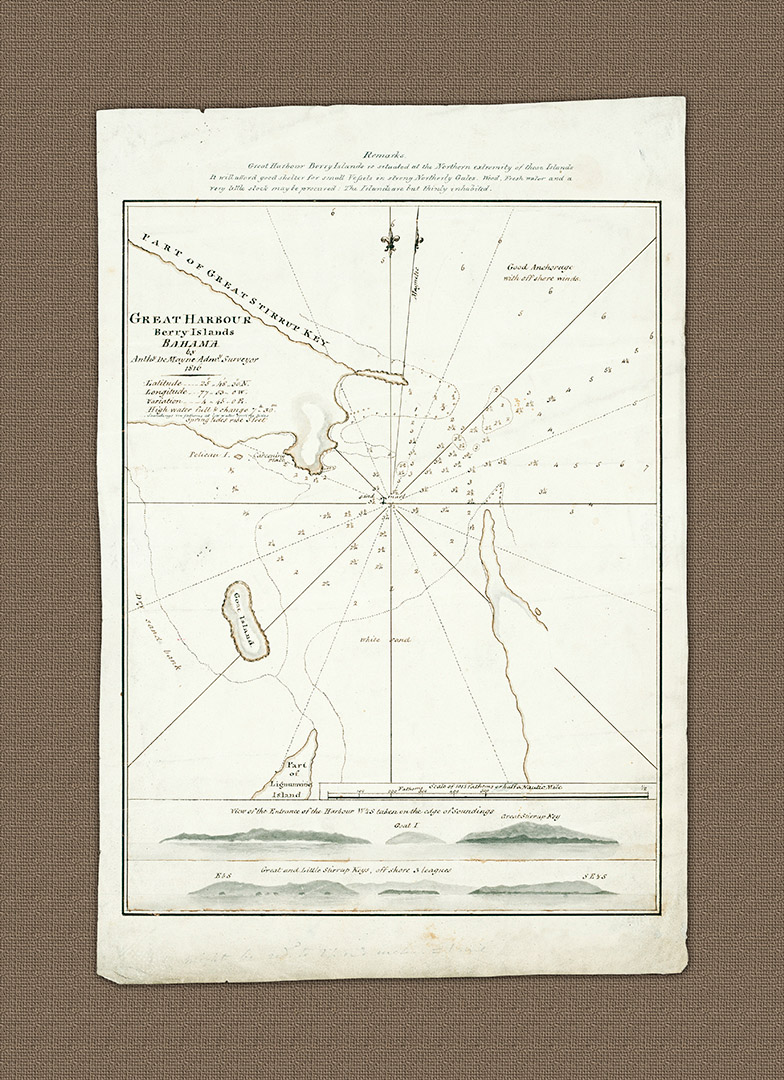A724 - Great Harbour, Berry Islands, Bahama
- 1816
- Anthony De Mayne
- h17" x w12.5"
- P
With this beautiful survey of Great Harbor, at the north end of what is Great Harbor Cay in the Berry island group, De Mayne places the harbor and its anchorage in the center of his manuscript and he does not spare the necessary hydrographical detail which includes standardized Admiralty symbols for tide directions, rock, shoals, sandbanks and anchorages.
As part of this larger survey of the Abacos, De Mayne concentrated on the small but potentially significant Islands harbors in the outer island region. All of these historic surveys produced by De Mayne were later copied and published in a less stylish fashion that lacks the color and style that De Mayne brought to this original work. As with the other original manuscripts in the collection he uses a subtle brown water-color outline to emphasis the coastlines.
At the bottom of the survey De Mayne has drawn and painted two views of the land as seen from sea. This, again, was fairly standard practice amongst the more talented Admiralty surveyors as it was a major assistance to sailors approaching such harbors for the first time. At the very top of the survey he has written a short description of the harbour and Islands and includes the note that 'the Islands are but thinly inhabited'.
The Latitude of the harbor is given by De Mayne as being; 25° 48' 30" and Longitude as; 77° 53' 0'. Out of interest, and with the benefit of modern satellite technology, the harbor is in fact at 25° 81' and 77° 89'. De Mayne includes on the survey a scale of 1015 fathoms, equating to half a nautical mile.
Tempting as it may be to test De Mayne's skill as a surveyor by sailing and navigating by his survey, Heritage Charts accepts no responsibility for such actions and advises against such activity.
Not until after the American Revolutionary War had finally ended in 1783 did the Bahamas and the outer islands of the Abaco take-on a noticeable, if not significant, role in history: With the expulsion of Loyalist sympathizers from their colonial holdings in 1782 the British government, which in itself had only until November 1783 to vacate the city of New York, it's last holding in America, struggled to find refuge for it's vanquished and now penniless supporters.
England apart, Canada was one option, the Abaco islands was the other. The first ship full of emigres had left New York in August 1783 for a land which British surveyor John Wilson described as being '..one fifth part of the face of the country is nothing but rock'. He went on to describe the suitability of whatever soil there was as being suitable only for; cotton, vegetables & guinea corn. As an estimation of sustainability Wilson's survey proved to be optimistic in as much as it would take a higher level of expertise and land management to fulfil the promises beyond the hopes of both the emigres and the British government, which frankly didn't exist.
By the 1790s civil unrest was boiling over, especially amongst the races. Initially, it seems, indenture had been implemented forcing even free blacks to 'belong' to whites. Many of the former slaves who had 'emigrated' complained that they thought, under British law that they would be free. With shortages of all kinds social order was further under threat. Agriculture had failed due to inefficient land management, cotton never developed as hoped on Abaco, although it had on the southern islands of Eleuthera.
When the provisions supplied by the British government had run out, starvation had taken hold for many. Many of the original Loyalist immigrants had moved away to Nassau or beyond. Only fledgling settlements and communities survived. A second immigration of people, this time from the more southerly Eluethera Islands, brought expertise in boat building, fishing and wrecking and these three industries in particular proved the way forward for many with towns such as New Plymouth on Green Turtle Cay and Hope Town on Elbow Cay springing-up and developing as a direct result of these industries.
References: 'Abaco: The History of an Out Island and its Cays'. Steve Dodge, Professor of History, Millikin University, Third Edition (2005). White Sound Press.
- Great Harbour, Berry Islands, Bahama


